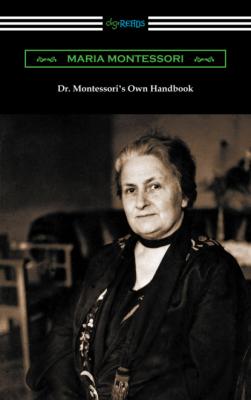Dr. Montessori's Own Handbook. Maria Montessori Montessori
Читать онлайн.| Название | Dr. Montessori's Own Handbook |
|---|---|
| Автор произведения | Maria Montessori Montessori |
| Жанр | Прочая образовательная литература |
| Серия | |
| Издательство | Прочая образовательная литература |
| Год выпуска | 0 |
| isbn | 9781420971835 |
DR. MONTESSORI’S OWN HANDBOOK
By MARIA MONTESSORI
Dr. Montessori’s Own Handbook
By Maria Montessori
Print ISBN 13: 978-1-4209-7182-8
eBook ISBN 13: 978-1-4209-7183-5
This edition copyright © 2020. Digireads.com Publishing.
All rights reserved. No part of this publication may be reproduced, distributed, or transmitted in any form or by any means, including photocopying, recording, or other electronic or mechanical methods, without the prior written permission of the publisher, except in the case of brief quotations embodied in critical reviews and certain other noncommercial uses permitted by copyright law.
Cover Image: a detail of a photograph of Maria Montessori, c. 1931 / Spaarnestad Photo / Bridgeman Images.
Please visit www.digireads.com
CONTENTS
LANGUAGE AND KNOWLEDGE OF THE WORLD
TO MY DEAR FRIEND
DONNA MARIA MARAINI
MARCHIONESS GUERRIERI-GONZAGA
WHO
DEVOTEDLY AND WITH SACRIFICE
HAS GENEROUSLY UPHELD
THIS WORK OF EDUCATION BROUGHT TO BIRTH IN
OUR BELOVED COUNTRY
BUT OFFERED
TO THE CHILDREN OF HUMANITY
Note by the Author
As a result of the widespread interest that has been taken in my method of child education, certain books have been issued, which may appear to the general reader to be authoritative expositions of the Montessori system. I wish to state definitely that the present work, the English translation of which has been authorised and approved by me, is the only authentic manual of the Montessori method, and that the only other authentic or authorised works of mine in the English language are “The Montessori Method,” and “Pedagogical Anthropology.”
Preface
If a preface is a light which should serve to illumine the contents of a volume, I choose, not words, but human figures to illustrate this little book intended to enter families where children are growing up. I therefore recall here, as an eloquent symbol, Helen Keller and Mrs. Anne Sullivan Macy, who are, by their example, both teachers to myself––and, before the world, living documents of the miracle in education.
In fact, Helen Keller is a marvelous example of the phenomenon common to all human beings: the possibility of the liberation of the imprisoned spirit of man by the education of the senses. Here lies the basis of the method of education of which the book gives a succinct idea.
If one only of the senses sufficed to make of Helen Keller a woman of exceptional culture and a writer, who better than she proves the potency of that method of education which builds on the senses? If Helen Keller attained through exquisite natural gifts to an elevated conception of the world, who better than she proves that in the inmost self of man lies the spirit ready to reveal itself?
Helen, clasp to your heart these little children, since they, above all others, will understand you. They are your younger brothers: when, with bandaged eyes and in silence, they touch with their little hands, profound impressions rise in their consciousness, and they exclaim with a new form of happiness: “I see with my hands.” They alone, then, can fully understand the drama of the mysterious privilege your soul has known. When, in darkness and in silence, their spirit left free to expand, their intellectual energy redoubled, they become able to read and write without having learnt, almost as it were by intuition, they, only they, can understand in part the ecstasy which God granted you on the luminous path of learning.
MARIA MONTESSORI.
Dr. Montessori’s Own Handbook
Recent years have seen a remarkable improvement in the conditions of child life. In all civilized countries, but especially in England, statistics show a decrease in infant mortality.
Related to this decrease in mortality a corresponding improvement is to be seen in the physical development of children; they are physically finer and more vigorous. It has been the diffusion, the popularization of science, which has brought about such notable advantages. Mothers have learned to welcome the dictates of modern hygiene and to put them into practice in bringing up their children. Many new social institutions have sprung up and have been perfected with the object of assisting children and protecting them during the period of physical growth.
In this way what is practically a new race is coming into being, a race more highly developed, finer and more robust; a race which will be capable of offering resistance to insidious disease.
What has science done to effect this? Science has suggested for us certain very simple rules by which the child has been restored as nearly as possible to conditions of a natural life, and an order and a guiding law have been given to the functions of the body. For example, it is science which suggested maternal feeding, the abolition of swaddling clothes, baths, life in the open air, exercise, simple short clothing, quiet and plenty of sleep. Rules were also laid down for the measurement of food adapting it rationally to the physiological needs of the child’s life.
Yet with all this, science made no contribution that was entirely new. Mothers had always nursed their children, children had always been clothed, they had breathed and eaten before.
The point is, that the same physical acts which, performed blindly and without order, led to disease and death, when ordered rationally were the means of giving strength and life.
The great progress made may perhaps deceive us into thinking that everything possible has been done for children.
We have only to weigh the matter carefully, however, to
